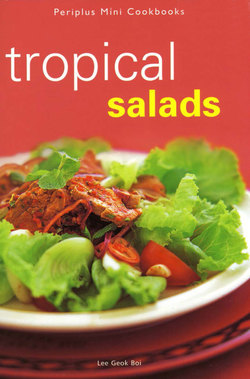Читать книгу Mini Tropical Salads - Lee Geok Boi - Страница 4
ОглавлениеTROPICAL SALADS can be eaten as meals on their own but taste best when served with curries and boiled rice which brings out their sharp, often contrasting, flavours. Chillies are to Asian salads what fragrant oils, lemon juice and vinegars are to Western salads. Whether combined with shrimp paste to make Sambal Belachan or simply pounded with lime juice, chillies add that extra bite to a plate of fruit or greens. More flavour is then introduced with shallots, onion and garlic—occasionally fried but usually raw.
Spicy salads are not just tangy. They are often flavoured with fragrant herbs and spices such as coriander leaves, spring onions, basil, Chinese celery and ginger flower (bunga kantari). Herbs and roots such as galangal and lemongrass lift the simple cabbage and cucumber to great heights of gastronomic delight.
A delicious feature of spicy salads is the use of raw—often green—fruit. Green mangoes, belimbi (belimbing asam), ambarella (buah kedondong) and pineapple all pack a great tangy flavour. Green papaya, water apple (jambu air) and starfruit (belimbing manis) are chosen because of their texture or juiciness and the way they combine with the dressing or dip.
Vegetables may be raw or lightly blanched, or a salad might combine both raw and blanched vegetables. Because of the high protein content of Asian salads, when eaten with rice they make a complete meal. However, in the typical communal eating style of Southeast Asia, a fish or meat dish would often be present to accompany the salad and rice. Nevertheless, there are a few salads which make great meals in their own right. Dishes such as Gado-Gado, Thai Glass Noodle Salad and Stuffed Beancurd may be taken alone or as part of a rice meal.
HOW TO PREPARE LIGHT SALADS From a dieter's point of view, many Asian salads have the added attraction of being relatively free of oil. The ingredients that give the salads their flavours—such as chillies, salt or fish sauce, lime juice, shallots and herbs—are essentially fat-free. For salads containing meat, use lean meat instead of belly pork. Both meat and seafood items are usually steamed or boiled.
The only exceptions to these fairly fat-free salads are those dishes calling for coconut milk or grated coconut, or which require an ingredient to be fried, such as Stuffed Beancurd. Beancurd could always be steamed or boiled instead of deep-fried though as the sauce would supply enough flavour to make the dish tasty for someone on a diet.
TO REDUCE PREPARATION TIMES The preparation times for salads can be reduced by having some of the ingredients ready mixed. Sambal Belachan, which can be made ahead, bottled and refrigerated, keeps well. As do roasted and pounded peanuts, and toasted grated coconut. Nuoc mam, the combination of lime juice, fish sauce, chillies and garlic that is used in Vietnamese salads can also be prepared in advance.
Shallots, garlic and spring onions can be sliced or chopped and stored in boxes for several days although freshly prepared ingredients display more intense flavours. The bulk of the herbs and fragrant roots, however, can only be prepared just before mixing. Although commercial coconut milk is an easier option for many, do try to use fresh coconut milk wherever possible.
HOW TO SEASON SALADS Because the flavours of spicy salads are sharp and distinctive, adjust them to suit personal preferences. Chillies can be very spicy or fairly bland. Tiny bird's-eye chillies are spicier than finger-length chillies; and long, thin chillies are spicier than fat ones. Vary the amount of salt or fish sauce and type and amount of chillies to suit your taste.
